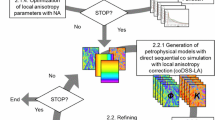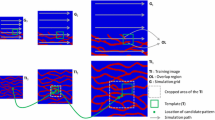Abstract
Large-scale reservoir architecture constitutes first-order reservoir heterogeneity and dietates to a large extent reservoir flow behavior. It also manifests geometric characteristics beyond the capability of traditional geostatistical models conditioned only on single-point and two-point statistics. Multiple-point statistics, as obtained by scanning a training image deemed representative of the actual reservoir, if reproduced properly provides stochastic models that better capture the essence of the heterogeneity. A “growth” algorithm, coupled with an optimization procedure, is proposed to reproduce target multiple-point histograms. The growth algorithm makes an analogy between geological accretion process and stochastic process and amounts to restricting the random path of sequential simulation at any given stage to a set of eligible nodes (immediately adjacent to a previously simulated node or sand grain). The proposed algorithm, combined with a multiple-grid approach, is shown to reproduce effectively the geometric essence of complex training images exhibiting long-range and curvilinear structures. Also, by avoiding a rigorous search for global minimum and accepting local minima, the proposed algorithm improves CPU time over traditional optimization procedures by several orders of magnitude. Average flow responses run on simulated realizations are shown to bracket correctly the reference responses of the training image.
Similar content being viewed by others
References
Deutsch, C., 1992. Annealing techniques applied to reservoir modeling and the integration of geological and engineering (well test) data: unpubl. doctoral dissertation, Stanford University, 306 p.
Dueck, G., and Scheuer, T., 1990, Threshold accepting: a general purpose optimization algorithm appearing superior to simulated annealing: Jour. Computational Physics. v. 90, no. 2, p. 161–175.
Farmer, C., 1991, Numerical rocks,in Fayers, F., and King, P., eds., The mathematical generation of reservoir geology: Oxford Univ. Press, New York, 9 p.
Guardiano, F., and Srivastava, M., 1992, Borrowing complex geometries from training images: the extended normal equations algorithm: Stanford Center for Reservoir Forecasting, Rept. No. 5, 15 p.
Journel, A., and Alabert, F., 1989, Non-Gaussian data expansion in the earth sciences: Terra Nova, v. 1, no. 2, p. 123–134.
Lewis, J. J. M., Hurst, A., and Lowden, B., 1990. Permeability distribution and measurement of reservoir-scale sedimentary heterogeneities in the Lochaline Sandstone (Cretaceous): Field Guide, 13th Intern. Sed. Congress (Nottingham, U.K.), 54 p.
Liu, K., Thiele, M., and Blunt, M., 1995, Comparison of the streamline method with conventional simulation: Stanford Center for Reservoir Forecasting. Rept. No. 8, 12 p.
Olson, J., and Pollard, D., 1989, Inferring paleostresses from natural fracture patterns: a new method: Geology, v. 17, no. 4, p. 345–348.
Omre, H., 1992, Heterogeneity models, SPOR Monograph: Recent advances in improved oil recovery methods for North Sea sandstone reservoirs: Norwegian Petroleum Directorate, Norway, 14 p.
Trans, T. T., 1994, Improving variogram reproduction on dense simulation grids: Computers & Geosciences, v. 20, no. 7/8, p. 1161–1168.
Wang, L., 1995, Multiple-point histogram in petroleum reservoir modeling: Stanford Center for Reservoir Forecastig, Rept. No. 8, 44 p.
Author information
Authors and Affiliations
Rights and permissions
About this article
Cite this article
Wang, L. Modeling complex reservoir geometries with multiple-point statistics. Math Geol 28, 895–907 (1996). https://doi.org/10.1007/BF02066007
Issue Date:
DOI: https://doi.org/10.1007/BF02066007




